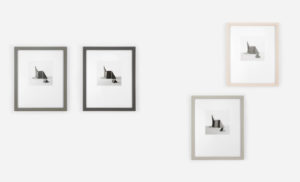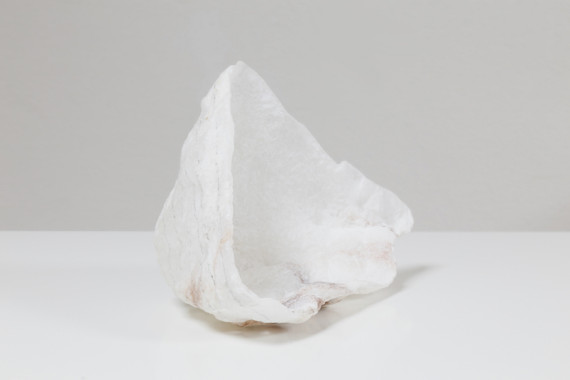To observe, study and confront the masters of the past has always been the prime mover of art history and the necessary presupposition of every emulation or breakage that handles its events. In the era of instantaneity and ubiquity postulated by the pervasive presence of virtual media it becomes more necessary than ever to strengthen the relationship with our roots in order to gain a broader critical perspective of the present contingencies. When a contemporary artist reflects on a work by a previous generation often he is able to highlight side elements and new possibilities of reading and makes more expressive consequences germinate. In this way the museum ceases to be the inert place of storage to resume its primary role of training and incubation of new creative potential, opposing active resistance to the dominance of the digital image as a source of knowledge and information.
These are the main reflections that arouses Mild Grey, site-specific project by the young Milanese duo Ornaghi & Prestinari, invited this year on the occasion of ART CITY Bologna to exhibit in Casa Morandi, the apartment- studio where the masterpieces of one the most beloved painters of the Italian ‘900 were born. The starting point of their research is the last painting by Giorgio Morandi, an essential composition of three objects detected by a tenuous agreement of broad and exhausted strokes and a soft side source of light. Recreating the set of the painting and its juxtaposition of objects, the artists have focused on the hidden part of these assemblies trying to precisely obtain the shadows and then realize them three-dimensionally in a series of clay sculptures that later became the subject of the pictures on display.
The artisan act of modeling the material to transform an impalpable shade into a structure where the traces of its bright negative are impressed is anything but an instinctive gesture as it might be assumed from the docile immediacy of plaster. If Morandi’s practice was based on a daily exercise of a painting that always insisted on the same themes to explore the indissoluble unity of form and light, sculptures by Ornaghi & Prestinari are the result of accurate studies on the window of Morandi’s studio carried with the aid of a sophisticated environment design software. Their process of elaboration and analysis of the empty Morandi’s studio has been turned into a video which shows the gradual emergence and identification of the environment that is defined only by the blazing rectangular opening, its reflection on the ground and the indirect and diffuse reverb of the dusty brightness that it exudes. Here, too, the light is at one with the matter and any imperceptible change in their respective dosages generates a new image and a different vision.
The disappearance of objects that unites photographs and video, while it reconsiders Morandi’s work regardless of the cliche “of the vase and the bottle” with which he is often superficially identified, accepts the imperative to essentiality from the great master who came to paint white the reality to be portrayed as not to disturb the harmony of his inner landscapes. If Morandi’s white was a speculative film to overlap to some real emergencies to match his mental archetypes, the mathematic installation of space by Ornaghi & Prestinari implies a subtraction work that is in the white its blank slate and initial condition.
The video projection is fronted by Piazza (2016), a sculpture in wood and alabaster, which incorporates in an abstract way the homemade machine with which the Milanese duo builds the frames of its work, in an ironic similarity with Morandi’s disappointment at the absence of frames that personally chose in the catalog images of his works. If the Bolognese master did intrude his idea of painting into the third dimension by changing the subjects of his still life and arranging the display of his paintings, the work of the Milanese originates from a blend of advanced technology and an equally strong craft skills by applying old and new techniques with the same attitude and the same design rigor.The inner journey in Morandi’s everyday life continues with a series of delicate incursions into the other rooms of the house, in which the artists placed small alabaster sculptures winking observer pretending to be confused with the lowly and legendary objects that surround them and their painted projections that inevitably their presence evoke. Fragile and transparent as an idea or an inspiration, these works implement a refined dialectic between fullness and emptiness that communicates with Morandi’s compositional principles reanimating and testing them from their place of origin.
So Shell (2016) is a portion of excavated stone that replicates inside the shape and the texture of the exterior trying to thin as much as possible the walls to obtain the widest portion of vacuum that the structure is able to contain, Full (2015) is a spoon placed on a book in which the concave part has been replaced by the convex one, while Chapeau (2016) is an ironic tribute to the master realized through the culmination of a beer bottle cap with a precious alabaster. In the relationship with domestic the artists try to dig down deep into the visible and to seek a common vocabulary that would be able to materialize the ideas still suspended in these rooms waiting to generate new forms. The attitude to experimentation and translation of the various facets of an intuition in several artistic languages also makes palpable the relativity of all time and perspective while preserving a personal and intimate dimension that makes it cozy their conceptual poetics.
Ornaghi & Prestinari. Grigio Lieve.
curated by Roberto Pinto
January, 21 – March, 12 2017
Istituzione Bologna Musei | Casa Morandi
via Fondazza 36, Bologna
 Ornaghi & Prestinari, Guscio, 2016, Alabastro / alabaster, 23 x 14 x 11 cm
Ornaghi & Prestinari, Guscio, 2016, Alabastro / alabaster, 23 x 14 x 11 cm
 Ornaghi & Prestinari, “Grigio Lieve”, 2016, Stampa a pigmenti colore su carta Hahnemühle, cornice d’artista in legno dipinto/ Colour pigment print on Hahnemühle paper, artists’ frame in painted wood, 39 x 32 cm
Ornaghi & Prestinari, “Grigio Lieve”, 2016, Stampa a pigmenti colore su carta Hahnemühle, cornice d’artista in legno dipinto/ Colour pigment print on Hahnemühle paper, artists’ frame in painted wood, 39 x 32 cm Ornaghi & Prestinari, Grigio Lieve, Casa Morandi, veduta della mostra, Foto Matteo Monti
Ornaghi & Prestinari, Grigio Lieve, Casa Morandi, veduta della mostra, Foto Matteo Monti Ornaghi & Prestinari, “Piazza”, 2016, Scultura in legno di olmo, mdf, alabastro
Ornaghi & Prestinari, “Piazza”, 2016, Scultura in legno di olmo, mdf, alabastro
 Ornaghi & Prestinari, “Pieno”, 2015, Alabastro e libro / alabaster and book, 28 x 22 x 6 cm
Ornaghi & Prestinari, “Pieno”, 2015, Alabastro e libro / alabaster and book, 28 x 22 x 6 cm
 Ornaghi & Prestinari, Still images (video), 2016, Ricostruzione 3D dello studio vuoto di Morandi / 3D reconstruction of the empty studio of Morandi
Ornaghi & Prestinari, Still images (video), 2016, Ricostruzione 3D dello studio vuoto di Morandi / 3D reconstruction of the empty studio of Morandi
Graduated in art history at DAMS in Bologna, city where she continued to live and work, she specialized in Siena with Enrico Crispolti. Curious and attentive to the becoming of the contemporary, she believes in the power of art to make life more interesting and she loves to explore its latest trends through dialogue with artists, curators and gallery owners. She considers writing a form of reasoning and analysis that reconstructs the connection between the artist’s creative path and the surrounding context.







NO COMMENT